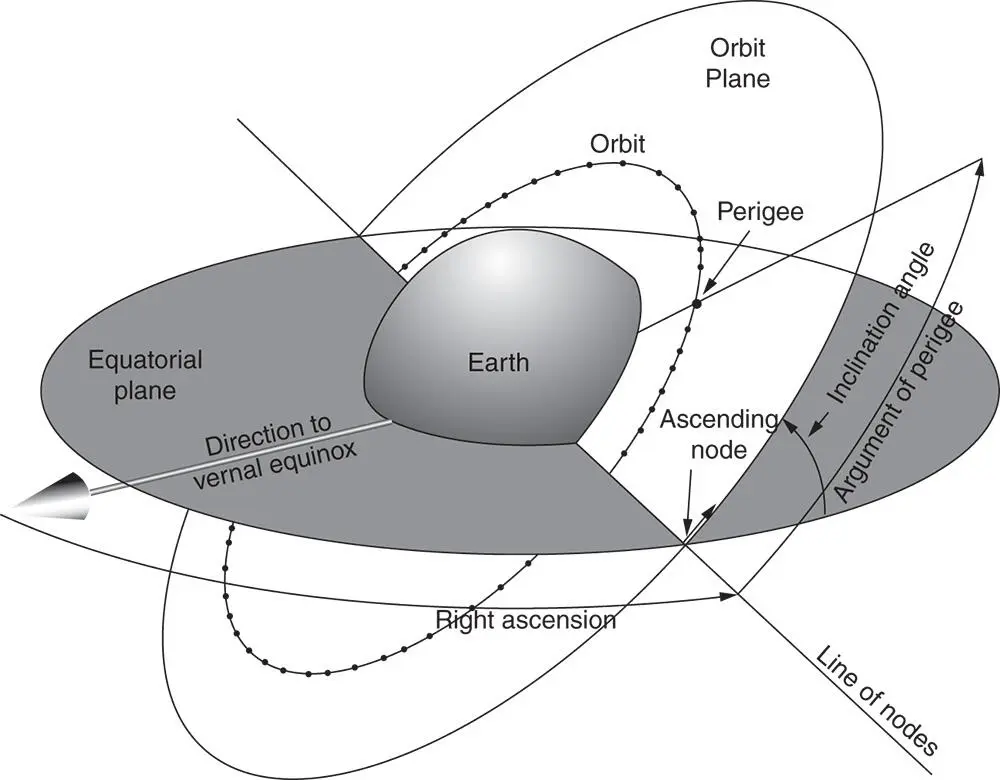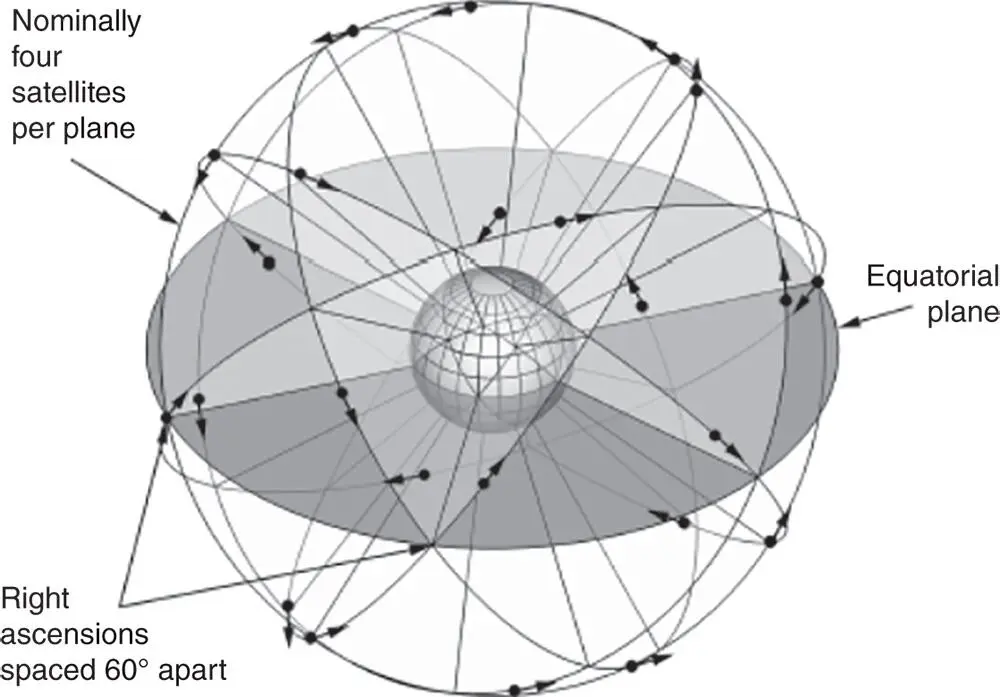2 Fundamentals of Satellite Navigation Systems
2.1 Chapter Focus
This chapter presents a concise system‐level overview of constellations, operational configurations, and signaling characteristics of a global navigation satellite system (GNSS). Various GNSSs have been developed over the decades to fulfill user position, velocity, and timing (PVT) application requirements. More detailed coverage of the essential technical details of various GNSSs is presented in Chapters 4–9.
2.2 Satellite Navigation Systems Considerations
Since the early days of satellite‐based navigation systems, they have operated independently and have been integrated with other radionavigation systems, as well as internal systems to increase the robustness of the PVT solution. While radionavigation systems, including GNSS, provide good accuracy, these types of systems may be vulnerable to interference and periods of unavailability. On the other hand, while inertial navigation systems are self‐contained, their accuracy degrades over time. The integration of these two complementary sensor systems enables the position navigation timing (PNT) engineer to implement a robust PVT solution for a variety of applications.
2.2.1 Systems Other than GNSS
In many parts of the Globe, GNSS signals have replaced other terrestrial radionavigation systems, such as long‐range navigation‐version C (LORAN‐C) signals produced by three or more LORAN signal sources positioned at fixed, known terrestrial locations for outside‐the‐building location determination. A LORAN‐C system relies on a plurality of ground‐based signal towers, preferably spaced 100–300 km apart, that transmit distinguishable electromagnetic signals that are received and processed by an LORAN receiver system. A representative LORAN‐C system is discussed in the US DOT LORAN‐C User Handbook [1]. LORAN‐C signals use carrier frequencies of the order of 100 kHz and have maximum reception distances of hundreds of kilometers. An enhanced version of LORAN (eLORAN) provides ranging from each independent station and enhanced data. The low frequency and high transmitter power in LORAN provides for a diverse PNT capability. Although LORAN has been decommissioned in the United States, other counties and regions continue and operate LORAN for an alternative to other radionavigation systems.
There are other ground‐based radiowave signal systems suitable for PVT applications. These include Multi‐lateral DME, TACAN, US Air Force Joint Tactical Information Distribution System Relative Navigation (JTIDS Relnav), US Army Position Location and Reporting System (PLRS) (see summaries in [2], pp. 6, 7 and 35–60), and cellular radiolocation services.
Cellular radiolocation services provide for enhanced 911 (E911) and location‐based services (LBSs). These PVT solutions may be based on GNSS or range and bearing determination using the actual cell towers. Two‐way ranging (e.g. round trip timing [RTT]), and bearing determination may be determined by antenna sector or advanced phase angle‐of‐arrival (AOA) determination. Several standards in the 3GPP and Userplane community govern the implementation ( http://www.3gpp.org/specificationsand https://www.omaspecworks.org/).
2.2.2 Comparison Criteria
The following criteria may be used in selecting navigation systems appropriate for a given application system:
1 Navigation method(s) used
2 System reliability/integrity
3 Navigational accuracy
4 Region(s) of coverage/availability
5 Required transmission frequencies and bands of operation
6 Navigation fix update rate
7 User set cost
8 Status of system development and readiness.
Early satellite‐based navigation systems c. 1960–1970, such as TRANSIT, utilized a low Earth orbit (LEO) to obtain sufficient Doppler on the carrier phase for positioning. In 1973, satellite navigation in the form of the global position system (GPS) took hold with the formulation of the GPS Program Office, which helps consolidate knowledge from the TRANSIT program, the Navy's Timation Satellites, and the USAF Project 621B satellite pseudoranging program.
Today, GNSSs use medium Earth orbit (MEO) for good visibility/availably of the satellite and still provide moderate Doppler for PVT determination. Some GNSSs also supplement the GNSS constellation with geostationary (GEO), geosynchronous, or inclined geosynchronous (IGSO). These GEO and/or IGSO satellites may provide additional ranging and a data link augmentation for the GNSS constellation.
The various governing bodies for satellite navigation publish technical interface control documents and specification on their respective GNSS. For GPS, the US Government publishes various Interface Specifications and performance specifications at GPS.gov[Ref. [2] in Chapter 4]. For the Russian GLONASS, a multitude of performance and system characterizations are published by the Russian Information and Analysis Center for Positioning, Navigation and Timing. For the European Galileo GNSS, these types of documents are published by the European Global Navigation Satellite Systems Agency [Ref. [26] in Chapter 4]. For the Chinese BeiDou Navigation Satellite System, information and official documents are published (Ref. [27] in Chapter 4). Other regional type satellite navigation systems cover a specific region of Globe such as the Japanese Quazi‐Satellite System (QZSS) (Ref. [29] in Chapter 4) and the Indian Regional Navigation Satellite System (IRNSS): NAVIC (Ref. [30] in Chapter 4) provide service and/or augmentation to a specific geographical region of the Globe.
Figure 2.1illustrates the key parameters that may be used to describe a GNSS satellite that orbits the Earth.
Various configurations may be used to complete a GNSS constellation. Various design parameters may be considered regarding the number of satellites, their location in the constellation, location on ground infrastructure components, and user segment service area.
GPS satellites occupy six orbital planes in an MEO that are inclined 55° from the equatorial plane, as illustrated in Figure 2.2. Each of the six orbit planes in Figure 2.2contains four or more satellites. The European Galileo and Chinese BeiDou use three orbital planes separated in longitude by 120°. Galileo has plans for 10 MEO satellites in each orbital plane. Glonass also used three orbital planes while maintaining a nominal 24 satellite constellation. GNSS augmentation or regional satellite‐based navigation systems are most often placed in GEO or IGSO over the region to be services; these satellites will have an orbital period of 24 hours.

Figure 2.1Parameters defining satellite orbit geometry.

Figure 2.2Six GPS orbit planes inclined 55° from the equatorial plane.
Regardless of the type of radionavigation (satellite‐based or terrestrial‐based) system, most often the solution method requires the determination of a unknown user antenna location with known transmitter locations and measured range (or pseudorange) observations.
2.3.2 Navigation Solution (Two‐Dimensional Example)
Antenna location in two dimensions can be calculated by using range measurements [3].
2.3.2.1 Symmetric Solution Using Two Transmitters on Land
Читать дальше














